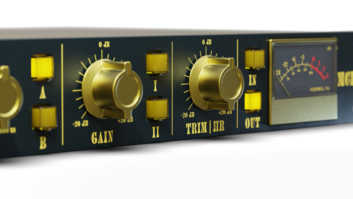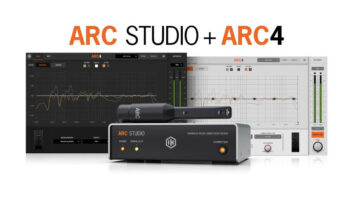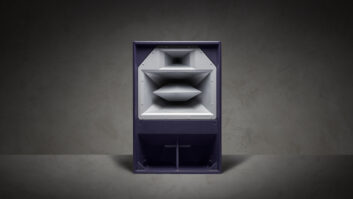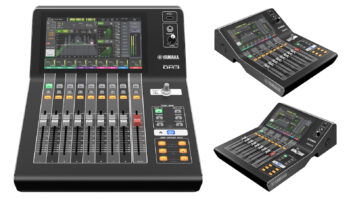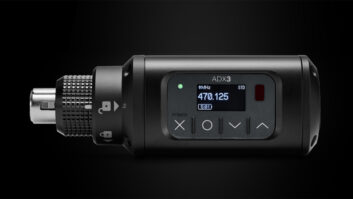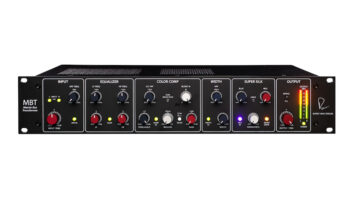It’s a truism these days in all worlds audio: Those who produce are working in the highest resolution possible, while those who consume often seem to be satisfied with MP3 quality. Until recently, 16-bit release limitations defined the divide between what the creators and consumers of content heard. But the gap has been closing in music and home theater with the advent of DVD. And now it’s closing in feature films.
On The Shipping News, Miramax’s holiday release based on the Pulitzer Prize-winning novel, the audio post team wanted to take full advantage of 24-bit location recordings, carrying the original files through to the final mix and the archival master. Despite the current buzz around all things 24-bit, it was not a simple task. But the decision to go through the experiment of a 24-bit dialog chain certainly added depth and space to the final release, and, as a whole, it’s a stellar track, full of air, dynamic range, subtlety, inventive design and some of the best dialog you will hear in a theater.
“We got involved before they started shooting,” recalls supervising sound editor and sound designer Michael Kirchberger. “We wanted to figure out some kind of way to take the 24-bit sound that Glen Gauthier recorded on a Nagra D and be able to access those original 24-bit files with an Avid OMF.” With help from assistant sound editor Roy Waldspurger, Kirchberger and the sound crew came up with a workaround.
“There are two problems,” Waldspurger explains. “First, we’re recording 24-bit and the Avid can only accept 16. Other films have done it using CMX lists, but we like to work in OMF because we can see exactly what Andy [Mondshein, the film editor] cut, down to the sample. The other problem we had was that Glen recorded 4-channel audio. This leads to a big problem during prep, because the dialog editor needs to be able to access other channels of that Nagra to make sure that he has the best recording. This is a problem in Pro Tools because the OMF does not give you access to all those other tracks. It will just give you whatever the picture editor cut.”
IT’S ALL IN A NAME
The Shipping News was recorded by Gauthier to a Nagra D, 4-track at 24-bit, using a combination of boom and radio mics. Those tracks were loaded digitally into a Tascam MMR-8 for telecine, then exported as Pro Tools sessions. (The OMF library was 130 gigabytes.) The sessions were sent to the picture department, where Jenny Davidoff Cook and Paul Wagtouicz hand-renamed all shots and takes consistently. Every take was then dithered down to 16 bits for import into the Avid, creating, according to Waldspurger, “parallel trunks in the tree,” — the original 24-bit files and the Avid import.
“Unfortunately, the by-product of importing it into the Avid is that it destroys the file name that we had worked so hard to get by removing characters and adding others,” Waldspurger says. “But I do picture assisting as well, and we knew of this hidden command in the Avid — you type it into the console — called RenameMediaFiles, which got us back our original names. Let’s say the original shot was called ‘042-01_1*4’; that would be shot 42, take 1, channel 1 of 4. After using the Rename command, the file names matched very closely to what we started with. The Avid would add an S.A1 [S for Shipping News] prefix and a suffix of .omf to the original file names. We then used a simple utility called Drop Rename to make our 24-bit master files match these new Avid names. If we had named the project anything longer than S, it would eat into the budget of 31 characters. At this point, the picture department and sound department files had the same exact names.
“Now the Avid does this hidden console command in a batch, so that doesn’t take much time, but it gave us the ability to get our OMF,” he explains. “We used Digi Translator, the typical OMF translation tool, and it has an option to spit out a 24-bit OMF that thought it should be giving us 24-bit audio. Sample for sample, these files were the same in length as the picture department. The only thing different was the bit depth. But the length and samples were the same, and it all matched up.
“The basic idea, that we cut with a parallel set of files, the credit goes to Larry Schalit, a sound editor friend of mine. He came up with the big idea.”
Finally, in order to have access to alternate tracks, Waldspurger wrote code in a language called Perl, which gave the dialog editor, David A. Cohen, access to all four tracks in a given take, no matter which track the picture editor, Andy Mondshein, cut in. The OMF track that Mondshein cut would expand into four channels, A1-4, in sync. “The filter I wrote took a Pro Tools 5.0-style session and produced a template,” Waldspurger explains. “If Andy cut five tracks of production audio, which he did in some cases, then it was 20 tracks that the dialog editor had sitting there.”
That, in turn, was a great boon for lead re-recording mixer Lee Dichter at the predub.
THE FINAL MIX
“Certain tracks were pulled, and the dialog editor had decided which ones to go with,” Dichter says. “In mixing them, I might say that I need another angle, or another microphone, what else do you have? We played directly out of Pro Tools into the dialog premix, so at any time I could ask David to find another mic to maybe make a better transition from a close-up to a long shot, or something like that. I could make the choice, or I could take two of them and do cross-dissolves at the console. Sometimes, I would ask him for all four channels and mix and match — start with one fader and go to another to make the transitions really smooth.”
Miramax booked the effects and dialog premix for the same time last fall at Sound One in New York. Dichter got a one-day head start on the dialog predub, then fed each day’s work upstairs for Reilly Steele to premix effects against. Steele then sat in for the final with Dichter at the 80-input Neve DFC.
Because they didn’t have access to Mondshein and director Lasse Hallström during the predubs, the re-recording team did what Kirchberger called “defensive mixing,” going 13 8-track units wide for effects, Foley and backgrounds. Though it was not an effects-intensive picture, there was a lot of overlap material in the way the film was cut, and Kirchberger wanted to be able to take it apart easily. Also, the console was set up identically for each reel — pre-planned, but nonetheless a luxury, Dichter said — and during some of Quoyle’s (Kevin Spacey) underwater nightmares, and in the few big moments, they needed the tracks.
EFFECTS AND FOLEY
The effects scenes in The Shipping News are not the main attraction, but there are moments when the design works particularly well emotionally — the musical nature of the wind through the house cables; or the bubbly, underwater silence of a grown man’s nightmares; or just the icy, airy, wider-than-the-screen backgrounds.
Kirchbeger made use of his extensive library and licensed much of the rest from a variety of sources. Lang Elliot, a sound effects recordist out of Ithaca, N.Y., whom Kirchberger first met on Ishtar, contributed indigenous birds and surf from the coast of Newfoundland. Some underwater material came from noted nature recordist Bernie Krause. Dan Gleich and Andy Aaron contributed additional effects. For the big house-moving-on-ice sequence, one of the elements was airplane skis on ice, which the late Alan Splet recorded for Never Cry Wolf.
Peer Landa, a composer in residence at CCRMA on the Stanford University campus, received an Additional Sound Design credit for his contribution, which melded wonderfully with Christopher Young’s music in many key scenes.
“He did most of the cables for us in the house scenes,” Kirchberger recalls of Landa, who is a friend of Waldspurger’s. “He started with real recordings of huge, huge cables that he tuned with a crowbar. He took those elements, processed them, then morphed them with a young girl screaming. He’s Norwegian but he grew up in Sweden. My big joke was that he knew more about what Lasse wanted in the soundtrack than the picture editor or any of us, because he spoke the language.”
Foley was performed by Margie O’Malley and Marnie Moore at the Saul Zaentz Film Center in Berkeley, Calif. Foley was mixed to Pro Tools by Frank Rinella, then edited by Jeremy Molod and George Berndt, all at 24-bit.
IN THEATERS
The Shipping News was mastered at 24-bit/48kHz and archived to an Akai DD8 drive. It was one of the first films in wide release to make use of Dolby’s new Digital Mastering Unit (DMU), which has digital inputs and dithers down to 20-bit, rather than the DS10’s 16-bit. “We complained to Brad [Hohle] from Dolby that we had to dither down to 20 bits to get into the DMU instead of going in the full 24,” Kirchberger laughs. “Some day, we can play this and get our extra four bits out. But hey, I would have been happy at 16-bit with Lee at the console. Nobody in the world makes dialog sing the way he does.”
Tom Kenny is the editor of Mix.
THE CREW
Sound Editorial by: Sound, San Francisco
Post-Production Sound Services by: Sound One Corp., New York City
Foley Recorded at: Fantasy Studios, Berkeley, Calif.
Supervising Sound Editor/Sound Design: Michael Kirchberger
Re-Recording Engineers: Lee Dichter, Reilly Steele
Recordists: Harry Higgins, Martin Czembor
Sound FX Editors: Steve Bissinger, Peter Staubli, Kyrsten Comoglio
Additional Sound Design: Peer Landa
Additional Sound Editor: Dan Korintus
Assistant Sound Editors: Roy Waldspurger, Everett Moore, Mick Gormaley
Apprentice Sound Editor: Michael Vangen
Sound Interns: Guru Mastak Khalsa, Lindsay Manning, Joel Dougherty
Sound FX Recording: Lang Elliot, Dan Gleich, Andy Aaron
Foley Artists: Margie O’Malley, Marnie Moore
Foley Mixer: Frank Rinella
Foley Recordist: Ben Conrad
Foley Editors: Jeremy Molod, George Berndt
Dialog Editor: David A. Cohen
ADR Editors: Jane McCulley, Laura Civiello
Assistant ADR Editor: Roland Vajs
ADR Engineers: David Boulton, Paul Zydel
Production Sound Mixer: Glen Gauthier


